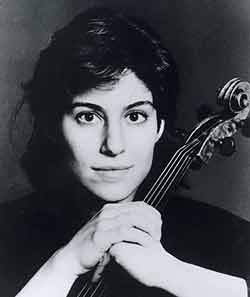Kim Kashkashian
The Much-Maligned Viola
December 5, 1999
| |
 |
| |
Kim Kashkashian
|
The viola - it quietly and unassumingly provides the inner voices in the symphony
or string quartet. You don't hear it very often as a solo instrument. And in the
musical world, it's often the butt of jokes. (Q. Why is viola called "bratsche"
in Germany?
A. Because that's the sound it makes when you sit down on it.
Q.Why shouldn't you drive off a cliff in a Beetle with three violas in
it?
A. You could fit in at least one more.)
So why is the viola so maligned? First of all, there's the assumption that the
violist, if he or she were really any good, would be a violinist. Richard Wagner
apparently once commented, "The viola is commonly (with rare exceptions)
played by infirm violinists, or by decrepit players of wind instruments who happen
to have been acquainted with a string instrument once upon a time." After
all, the violin is the star-the champagne of the string world-playing those virtuosic
passages, hogging the limelight with the melody line, singing up high where everyone
can hear, with all those frilly trills and fast notes. The viola tends to get
the meatloaf and mashed-potato notes. Plus there's really very little solo music
for the viola compared to the violin-the viola usually gets stuck playing along
with the bass line or echoing the violin's melodies. Then there's the traditional
orchestra hierarchies-the first violinists are tops, followed by cellos, second
violins, violas and basses. It's the proverbial "kick the dog" situation.
(See Carl Rahkonen's piece, "No Laughing Matter: The Viola Joke as Musician's
Folklore", found on The Viola Web Site.)
Part of the difficulty for the violist is that instrument makers have been struggling
over the centuries to find a good balance between size and timbre (or sound quality).
The violin and the cello are more ideally proportional in length and thus have
a clearer sound than the more veiled tone of the viola. Ideally the viola should
be a bit larger to get the best timbre, but that would make it even more difficult
to play. As the viola master William Primrose once remarked, "The viola is
difficult enough without having to indulge in a wrestling match with it."
Today's violists have to be fairly athletic to handle the instrument-they have
a longer and more awkward stretch with their left hands, and need to use greater
pressure on both fingerboard and bow than the violinists.
Then there's the problem of getting the soft-spoken, purple-toned viola to stand
out against an orchestra. The violin and the cello are more able to ring out over
a full orchestra-which is why there are fewer solo pieces for the viola. As Cecil
Forsyth noted in his book Orchestration (1914), composers often didn't really
know what to do with the viola. "The instrument was there and had to be written
for. Interesting ... middle-parts were, however, still a thing of the future.
The viola, therefore, either did nothing or something which by the ingenuity of
the composer was made to appear as much like nothing as possible."
But the paucity of excellent music for the viola, and the quality of playing,
is certainly the stuff of mere folklore. The artistry of modern violists nips
in the bud any doubts about the beauty or versatility of the instrument. And the
viola has had some illustrious champions-Bach liked to play viola so he could
be "in the middle of the harmony" and relaxed by bowing away on his
viola, Beethoven started out as a violist in the court orchestra in Bonn, and
Mozart himself was an excellent violist and wrote some marvelous pieces for
it. In fact, 18th-century composers such as Hadyn and Mozart recognized the viola's
potential and started to write for it as a solo instrument. It was in that century,
too, that the viola took its place as a fixture in the standard string ensembles
that we know today - the string quartet, quintet and trio. (Reasons why, violists
might argue, the 18th century is nicknamed the Age of Enlightenment.) And finally,
in the 19th century, composers such as Brahms and Berlioz helped to unleash the
viola from any remaining prejudices. The rise of the Romantic style, which needed
the subtle coloring of the viola to achieve its lush effects, and the emergence
of the viola virtuoso, brought the viola into its own.
The viola has indeed been much maligned. It's just that the stuff of folklore
- or old prejudices-are hard to dispel.
Want to hear some more of the viola repertoire? Here's a few suggestions:
Mozart: Concerto for Violin and Viola (K364/320d, 1779)
Mozart: Quintet in G minor for Two Violins, Two Violas and Cello (K516, 1787)
Hector Berlioz: Harold en Italie
Johannes Brahms: Serenade (Op. 16)
Bela Barók: Viola Concerto (1949, posthumous)
William Walton: Viola Concerto (1929)
|
